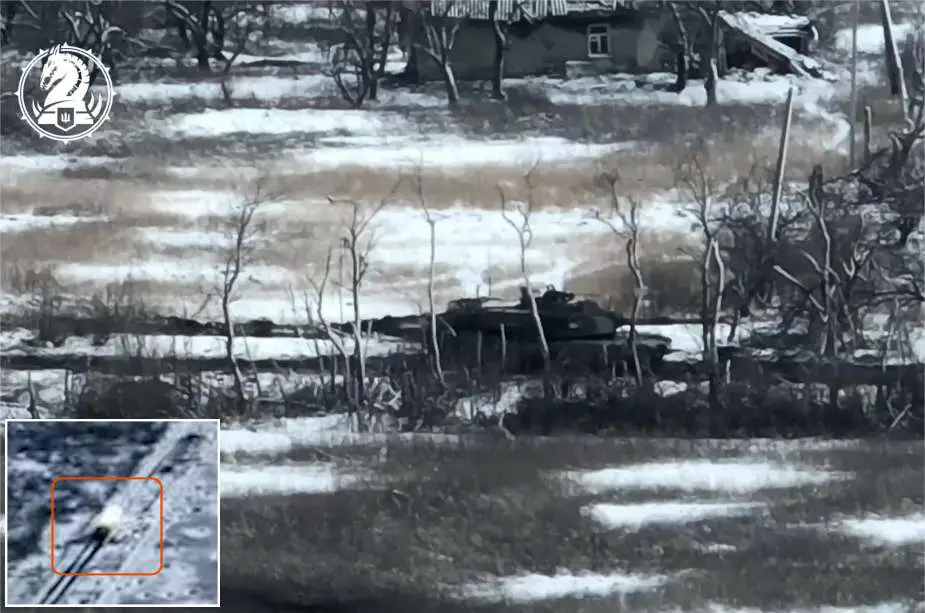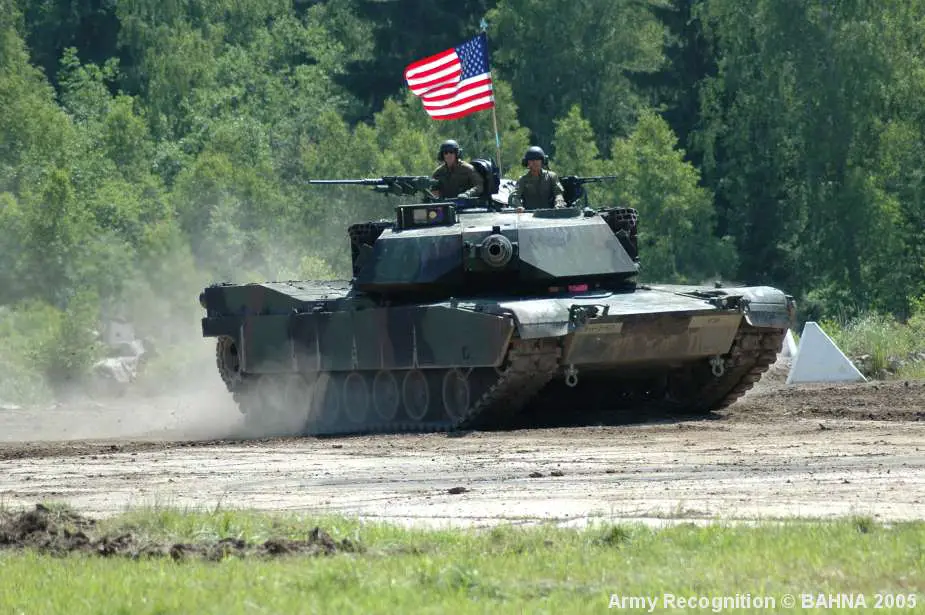On February 23, 2024, the 47th Separate Mechanized Brigade of the Ukrainian Armed Forces unveiled footage showcasing the first combat deployment of the US-supplied M1A1 Abrams Main Battle Tank against Russian forces. This marks a significant milestone following the confirmation by both Ukrainian soldiers and US officials in November 2022 that all 31 Abrams tanks donated to Ukraine had reached their intended destination.
Follow Army Recognition on Google News at this link

The M1A1 Abrams is equipped with substantial firepower, thanks to its 120mm smoothbore gun, capable of firing the M829A1 APFSDS-T round. This round features a depleted uranium penetrator with a range of up to 4,000 meters. (Picture source: 47th Separate Mechanized Brigade)
Colonel Martin O’Donnell, spokesperson for the US Army Europe and Africa, confirmed in an interview with Voice of America on October 16, 2023, the successful delivery of the promised 31 M1A1 Abrams Main Battle Tanks to Ukraine, along with essential ammunition and spare parts. This fulfillment of commitments made by the Biden administration was preceded by an earlier report on August 8, 2023, forecasting the anticipated deliveries. Ukrainian personnel, having undergone training alongside US forces in Germany, have returned to Ukraine fully prepared to operate the newly acquired tanks.
The integration of Abrams tanks into Ukraine's military arsenal aligns with a broader strategy aimed at strengthening the country's defensive capabilities, including a reinforced focus on domestic production. These tanks will complement existing Western-manufactured models already in Ukraine's possession, such as the Swedish Stridsvagn 122, German Leopard 2A4 and 2A6, and British Challenger 2.
However, the decision-making process regarding the timing and location of deploying this new capability now falls upon Ukrainian authorities. This deliberation period may extend as Ukrainian military strategists evaluate their support infrastructure and formulate effective deployment strategies against Russian forces. It is crucial to acknowledge that Ukraine's strategic decisions hold considerable significance in shaping the conflict's outcome, with the successful operation of the tanks contingent on their coordinated deployment alongside infantry and other military assets.
At present, Ukrainian forces confront well-fortified Russian positions across a substantial frontline. The introduction of Abrams tanks is expected to enhance their firepower and aid in maneuvering through these fortified positions. Nevertheless, uncertainties persist due to the refurbishment process, which involves the removal of sensitive technologies, including classified depleted uranium armor, from older vehicles. Recent events have underscored the effectiveness of Russian forces in neutralizing Western-supplied tanks like the Challenger 2 and Leopard 2A4.
Reports from September 25, 2023, reveal that Russians have already begun sharing guidelines and strategies for countering US-made Abrams tanks with anti-tank-guided missiles (ATGMs). While the possibility of Abrams tanks being targeted during the conflict is anticipated, their crews are expected to have a higher chance of survival compared to crew members of older Soviet tanks.
The M1A1 Abrams Main Battle Tank represents a significant advancement from its predecessor, the M1 Abrams Main Battle Tank (MBT). Produced from August 1985 to early 1993 under the supervision of General Dynamics Land Systems, this version boasts numerous improvements, including enhancements to its suspension system, augmented armor protection, and a redesigned turret gun mount. With over 4,796 units manufactured for the US Army and an additional 221 for the US Marines, it has become a standard main battle tank for the US armed forces. Several other nations, including Egypt, Australia, Iraq, Poland, and now Ukraine, have also integrated this armored vehicle into their tank fleets.
The main armament of the M1A1 Abrams includes one 120mm M256 smoothbore gun serving as its primary armament, capable of deploying various types of ammunition, including the M829A1 APFSDS-T round, featuring a depleted uranium penetrator effective at piercing armor. During Operation Desert Storm, its range demonstrated effectiveness up to 4,000 meters. Complementing this is the M830 High Explosive Anti-Tank (HEAT) round, effective against fortified targets within 3,000 meters. The M1A1 Abrams carries a total of 40 rounds of 120mm ammunition stored within the tank, with 34 in the turret bustle and six in a rear hull box.
Additionally, the M1A1 Abrams features several machine guns, including a coaxial 7.62mm machine gun, and a similar 7.62mm machine gun mounted on the left side of the turret, while a standard 12.7mm Browning M2 HB machine gun on the commander's hatch enhances defensive capabilities. These armaments contribute to the M1A1 Abrams' versatility and effectiveness in various combat environments.
The hull and the turret armor protection features Chobham composite armor with integrated depleted uranium plates, offering defense against both kinetic energy and chemical energy threats. The Chobham is composite armor that uses ceramic technology and various materials with different hardness and elasticity, heat and shock-absorbing materials, layered and sandwiched together, to provide improved protection against specific threats, such as multiple hits of Kinetic Energy (KE), and Chemical Energy (CE) ammunition. The M1A1 includes also a depleted uranium (DU) plate which provides resistance against kinetic energy rounds. The driver is seated at the front of the vehicle in the center and operates the vehicle from a semi-reclining position when driving with the hatch closed. The commander and gunner are seated on the right of the turret and the loader on the left. The crew compartment is separated from the fuel tanks by armor bulkheads. Sliding armor doors and armor-protected boxes isolate the crew from the onboard main armament ammunition explosion.
Powered by a Honeywell AGT 1500 gas turbine engine, the M1A1 can reach speeds of up to 68 km/h, facilitating movement across diverse terrains, including steep gradients, water obstacles, and trenches. Additionally, the tank is outfitted with various accessories, such as a fire control system, laser range finder, night vision equipment, thermal sight, NBC (Nuclear, Biological, and Chemical) protection, and an automatic fire extinguishing system.

Powered by a Honeywell AGT 1500 gas turbine engine, the M1A1 can reach speeds of up to 68 km/h, facilitating movement across diverse terrains, including steep gradients, water obstacles, and trenches. (Picture source: Army Recognition)
















